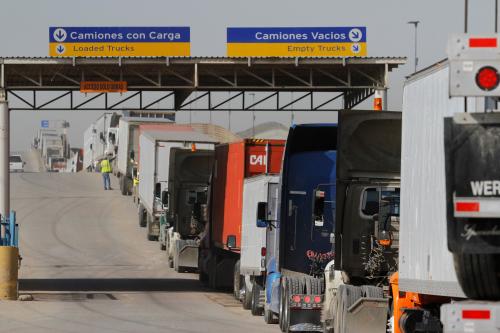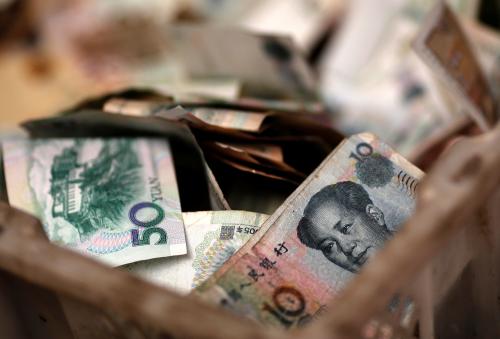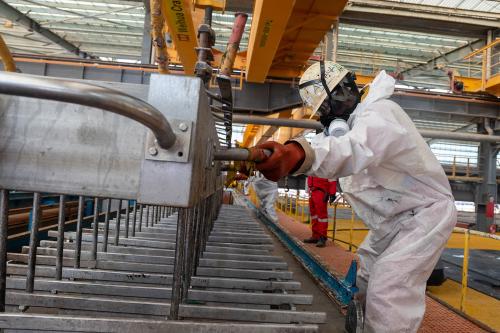This piece was originally published by The Hill.
President Trump has blamed international trade and, specifically, bad trade deals signed by his predecessors, for the loss of manufacturing jobs in the U.S. During the presidential campaign, he threatened to raise tariffs on imports from China and Mexico and promised to renegotiate the North American Free Trade Agreement (NAFTA) and other trade deals where the U.S. has a bilateral trade deficit.
Coming into office, President Trump immediately began to fulfill some of these campaign promises. Trump’s inauguration speech outlined his harsh zero-sum view of international trade, stating that “protection will lead to great prosperity and strength.”
In his first week in office, Trump withdrew the U.S. from the Trans-Pacific Partnership (TPP) agreement. At the G-2O, the administration’s position on trade meant that the G-20 broke from its usual stance of committing to a standstill and rollback of protectionist measures.
Yet, leaders at a November Asia-Pacific Economic Cooperation (APEC) session collectively pledged support for a standstill until the end of 2020 and reaffirmed the goal of a Free Trade Area of the Asia-Pacific (FTAAP).
At the same time, other anticipated trade actions by team Trump did not materialize. For instance, the U.S. Treasury did not label China a currency manipulator, nor were tariffs imposed on China and Mexico.
Instead, following Trump’s meeting with President Xi Jinping in April, there was a 100-day trade plan that includes improvements in market access for U.S. beef, financial services, and biotech exports.
During Trump’s visit to Beijing in November, President Xi promised his country would invest billions in the U.S., and Trump said that China is not to blame for the deficit, but past presidents are at fault. All this left China last year feeling they had successfully navigated the risks Trump presented to the bilateral economic relationship.
Trump also did not pull the U.S. out of the WTO, NAFTA, or any other trade agreement, despite threats to do so. Instead, the U.S. trade representative is now in the midst of renegotiating NAFTA.
The administration started a Section 232 investigation into the impact of imports of steel and aluminum products on U.S. national security and a Section 301 investigation into China’s intellectual property rights practices, but no outcome was forthcoming in 2017.
At the end of one year of President Trump, one could conclude that the trading system, while somewhat battered, remained intact.
However, risks of trade actions are higher this year for three reasons. First, various political considerations that stayed Trump’s hand on trade no longer exist, in particular the focus on repealing the Affordable Care Act and passing corporate tax cuts.
Second, the Section 232 process has been finalized, and the Section 301 process will conclude shortly, creating a legal basis for action. Third, there is a growing political imperative for Trump to show more aggressive trade action.
The following outlines key trade action we could see this year.
NAFTA
Chances of Trump pulling the U.S. out of NAFTA are higher. Trump sees leaving NAFTA as a clever negotiating tactic that could force Mexico and Canada to agree to U.S. demands. This could be bluster, as he did not mention NAFTA withdrawal in his January 2018 speech at the American Farm Bureau Federation’s convention.
Pursuing such a strategy could lead to the end of NAFTA. It would make it even more difficult for Mexican President Peña Nieto and Canadian Prime Minister Justin Trudeau to compromise under such a public threat from the U.S. Yet, with Trump having staked much of his reputation as a keen negotiator on such a move, there would very little room for the U.S. to back to down.
Actually leaving NAFTA would cause economic harm for U.S. businesses and consumers. It would also have other negative impacts on U.S. credibility that could be very costly over time. NAFTA withdrawal would erode the value of all other U.S. trade agreements as other governments and businesses discount U.S. commitments.
It would also further reduce the willingness of other leaders to spend political capital to agree on new trade agreements with the U.S.—compounding the costs to U.S. economic leadership from pulling out of the TPP.
Section 301 investigation into China’s intellectual property practices
The Section 301 report is likely to be a basis for significantly more robust trade and other economic action aimed at China.
The key question will be whether the administration responds strategically and in line with U.S. trade law commitments or if it violates U.S. WTO commitments. The latter response would lead to WTO disputes and retaliatory action from China.
Section 232 investigation on imports of steel on U.S. national security
On Jan. 12, the Commerce Department submitted to the president its Section 232. Should the president impose trade restrictions on steel and aluminum imports, this will hit imports not just from China, but also from allies, such as Australia, Canada, Japan, and South Korea. Downstream industries in the U.S. that use steel as an input, including the auto industry and equipment manufacturers, would also be hurt.
Such action could have systemic ramifications for the trading system. China, for instance, has identified large areas of its economy, from energy to information technology, as strategically important and subject to investment restrictions. The U.S. using national security to justify sweeping trade restrictions would give cover for other countries to do the same.
Some final thoughts
Predicting how Trump will act on trade is challenging, and he might be less aggressive this year for reasons of expediency. For one, he has learned that NAFTA is in fact important for auto manufacturers and farmers.
Moreover, a trade war could stall economic growth and negatively affect the stock market. This underscores the challenges for Trump as he seeks to reconcile the economic realities of trade with his campaign rhetoric.
The Brookings Institution is committed to quality, independence, and impact.
We are supported by a diverse array of funders. In line with our values and policies, each Brookings publication represents the sole views of its author(s).







Commentary
Op-edBattered in 2017, trade may face Trump’s full wrath in 2018
January 22, 2018